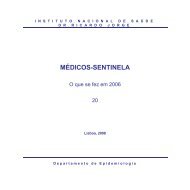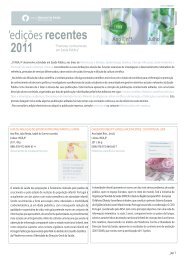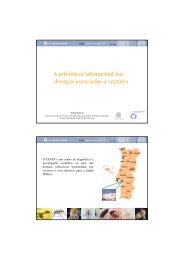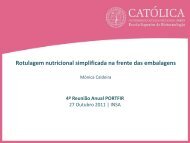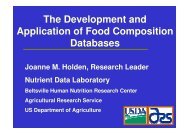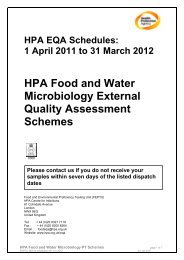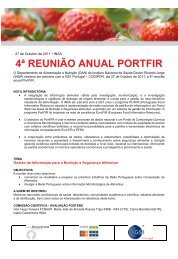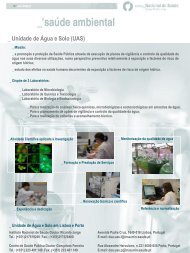European Society of Mycobacteriology - Instituto Nacional de Saúde ...
European Society of Mycobacteriology - Instituto Nacional de Saúde ...
European Society of Mycobacteriology - Instituto Nacional de Saúde ...
You also want an ePaper? Increase the reach of your titles
YUMPU automatically turns print PDFs into web optimized ePapers that Google loves.
c^<br />
PP-56<br />
MYCOBACTERIA IN ANIMALS IN SLOVENIA –<br />
AN OVERVIEW OF THE LAST DECADE<br />
Mateja PATE 1 , Darja FERME 1 , Manca ŽOLNIR DOVC 2 , Matjaž OCEPEK 1<br />
1 - Veterinary Faculty Ljubljana, Gerbiceva 60, SI-1115 Ljubljana, Slovenia;<br />
e-mail: matjaz.ocepek@vf.uni-lj.si ; fax: +386 1 4779 352<br />
2 - University Clinic <strong>of</strong> Respiratory and Allergic Diseases Golnik, Golnik 36, SI-4204 Golnik, Slovenia<br />
^<br />
C<br />
Successful national control program carried out between 1962 and 1973 contributed to eradication <strong>of</strong> bovine tuberculosis<br />
(BTB) in Slovenia. Since then, infections with the causative agents <strong>of</strong> BTB were seldom <strong>de</strong>tected. The main role <strong>of</strong><br />
veterinary mycobacteriologists has therefore become the <strong>de</strong>tection and i<strong>de</strong>ntification <strong>of</strong> the causative agents <strong>of</strong> avian<br />
tuberculosis and opportunistic mycobacterial pathogens. The aim <strong>of</strong> this study was to summarize the work done in the<br />
past ten years (1999-2008) in the field <strong>of</strong> veterinary mycobacteriology in Slovenia.<br />
I<strong>de</strong>ntification <strong>of</strong> the isolates was based on the following features and tests: colony morphology and growth characteristics,<br />
biochemistry, PCR and commercial i<strong>de</strong>ntification kits AccuProbe (Gen-Probe) and GenoType (Hain Lifescience).<br />
From 1999 to 2008, a total <strong>of</strong> 292 mycobacteria were isolated from domestic, pet and wild animals in captivity. The vast<br />
majority <strong>of</strong> isolates were represented by M. avium (80.1%), i<strong>de</strong>ntified to subspecies level in 92.7% (M. a. subsp. avium –<br />
36.3%, M. a. subsp. hominissuis – 56.4%), while 7.3% isolates remained i<strong>de</strong>ntified as M. avium. These mycobacteria were<br />
found predominantly in pigs, followed by cattle, poultry and exotic birds. M. caprae was found in 1.4% cases and was<br />
related to an outbreak in a zoo, affecting bisons and camels, and to a single culture-positive case <strong>of</strong> BTB in cattle in the<br />
last 15 years. M. tuberculosis was found in one cow (0.3%) as a consequence <strong>of</strong> human-to-animal transmission proven by<br />
means <strong>of</strong> molecular epi<strong>de</strong>miology. Other species <strong>de</strong>tected inclu<strong>de</strong>d M. terrae (0.7%, pigs), M. fortuitum (0.7%, pig & cattle),<br />
M. scr<strong>of</strong>ulaceum (0.3%, bison) and M. celatum (0.3%, pig). A relatively large proportion <strong>of</strong> isolates (16.1%) originating from<br />
pigs, cattle, sheep, goat, mouflon, bison and monitor lizard were i<strong>de</strong>ntified to the genus level only. This could be partly<br />
attributed to the lack <strong>of</strong> reliable i<strong>de</strong>ntification methods in the past.<br />
Development <strong>of</strong> diagnostic kits based on molecular tests led to improved and easier diagnostics <strong>of</strong> mycobacteria, especially<br />
<strong>of</strong> the species commonly found in the environment, therefore reducing the bur<strong>de</strong>n <strong>of</strong> uni<strong>de</strong>ntified mycobacteria in<br />
a routine laboratory.<br />
128 ESM 2009



